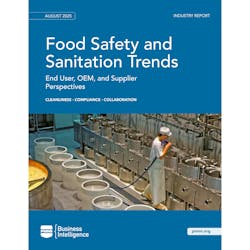PMMI study highlights top food safety and sanitation challenges for manufacturers
Food safety and sanitation remain critical priorities for the food and beverage manufacturing industries, shaping processes, equipment design, and compliance efforts. A new report from PMMI, The Association for Packaging and Processing Technologies, highlights that employee training and digital integration remain major challenges for companies striving to meet food safety regulations.
According to Food Safety and Sanitation Trends: End User, OEM, and Supplier Perspectives, more than half of surveyed manufacturers identified employee training as their top challenge in maintaining compliance. Respondents also cited difficulties in coordinating with stakeholders and tracking evolving regulations.
The report notes that while digital tools are becoming more prevalent, most facilities have yet to reach the level of integration needed to optimize safety and sanitation systems. Only 16% of end users currently use enterprise resource planning software in their sanitation processes. PMMI President and CEO Jim Pittas said that original equipment manufacturers (OEMs) and suppliers can play a key role in helping manufacturers connect sanitation processes with broader operational systems.
At present, most end users prioritize core sanitation fundamentals — such as selecting non-porous materials, ensuring corrosion resistance, and sealed components — over advanced automation features. These measures reflect a focus on durability and cleanability amid increasingly aggressive sanitation protocols. However, OEMs that innovate toward digital integration and automated cleaning may gain an advantage as end users look ahead to more connected operations.
Despite widespread use of corrosion-resistant equipment, many manufacturers continue to experience wear related to sanitation chemicals and procedures. This finding suggests an ongoing need for material and design improvements. Jorge Izquierdo, vice president of market development at PMMI, emphasized the importance of collaboration between OEMs, suppliers, and end users to stay current with regulations and adapt machinery accordingly.
The report concludes that OEMs positioned to meet today’s core sanitation requirements — while investing in future-ready, digitally connected solutions — will be best equipped to support the next phase of food safety innovation in manufacturing.
This piece was created with the assistance of generative AI tools and was edited by our content team for clarity and accuracy.
